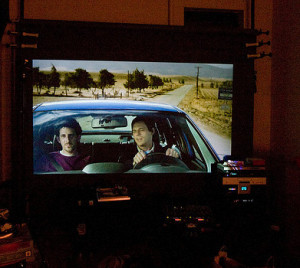Business Projectors vs Home Theater Projectors
 Buying a projector? Here’s what you need to know about the differences between business and home theater projectors.
Buying a projector? Here’s what you need to know about the differences between business and home theater projectors.
Main differences
Business projectors are used in a variety of settings to display multimedia presentations while home theatre projectors are dedicated to playing film and TV in conjunction with a Blu-ray player to cable connection.
Knowing what each projector has to offer can help you narrow down your choices. Here are the top four considerations to make before purchasing your business or home theatre projector.
 Business Projectors
Business Projectors
There are four main areas to consider when looking at a projector for a business environment that is going to be displaying multimedia presentations:
- Brightness. Lumens refer to the brightness of the projector; the higher the lumens, the brighter the image. Business presentations are often done in large rooms so the projector must have enough power to project the image clearly in a fully lit room. Generally you want a projector between 1,500–2000 lumens for rooms with limited light or 2,000–2500 lumens for rooms with bright ambient light such as a conference room in an office that is sunny or well lit.
- Portability. You’ll need a projector that is easy to carry to business meetings and presentations. Larger, heavier models are only suitable for permanent installations. The more mobile you are with your projector, the smaller and lighter it needs to be.
- Connections. You’ll want the maximum outputs on your projector so you can hook it up to your computer or other source device in order to display the presentations. You want maximum flexibility so you can hook up using a VGA connection (computer monitor), a USB connection (same connection for a printer, scanner or digital camera), a DVI cable (digital video) or a HDMI cable (High Definition Multimedia Interface).
- Easy set-up: You don’t want to waste time setting up or waiting for the projector to power-up. Look for a projector that is responsive and quick.
 Home Theater Projectors
Home Theater Projectors
Home theaters are going to be part of your home entertainment center so you need to look at some specific things in order to get the best fit:
- Resolution: A projector’s pixel count determines its resolution. The more pixels there are, the clearer and crisper the picture will be. Higher resolutions let you sit closer to the screen. Most DVD players have a 490p (progressive scanning) while 720p is the minimum for HDTV. You’ll want to go with 1080p since this is the minimum resolution you can have for Blu-ray, PlayStation, Xbox360 and other high-resolution devices. Your cable box may be broadcasting at a lower resolution for check to see how well the projector handles lower resolutions.
- Contrast Ratio: The ratio between the brightest and darkest areas is known as the contrast ratio. A higher contrast ratio gives more vibrant colors, crisper pictures and more details showing up in the dark areas on the screen. This can be important when matching films and videos.
- Throw ratio: This is one of the most critical elements for a home theatre projector. Throw ratio is measured by the projector’s distance (D) from the lens to the screen divided by the width (W) of the image projected. For each foot of image width, the projector needs to be two feet away or D/W = 2/1 = 2.0. A projector with a throw ratio of 2.0 will have a five-foot wide image. If the projector is 20 feet away then the image must be 10 feet wide. Check to see if the projector has a short throw – the ability to cast the image at a short distance. You’ll need to calculate correctly before mounting your projector and screen for your home theater.
- Connectivity: You’ll need at least one HDMI input to connect to either your cable or satellite box. You will want more if you plan to also run a Blu-ray player or gaming console. Make sure the build in audio is high enough quality or can work with a separate sound system.

Leave a Reply